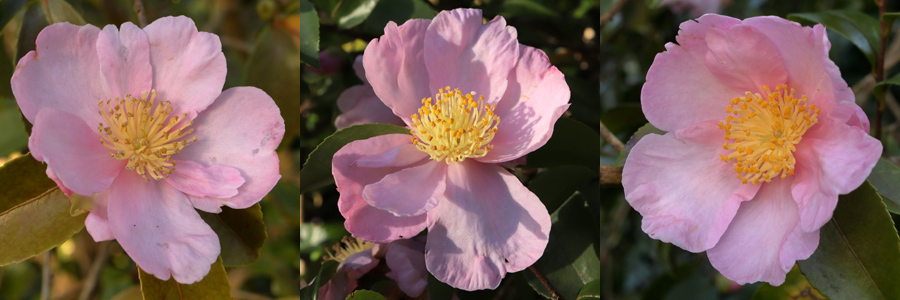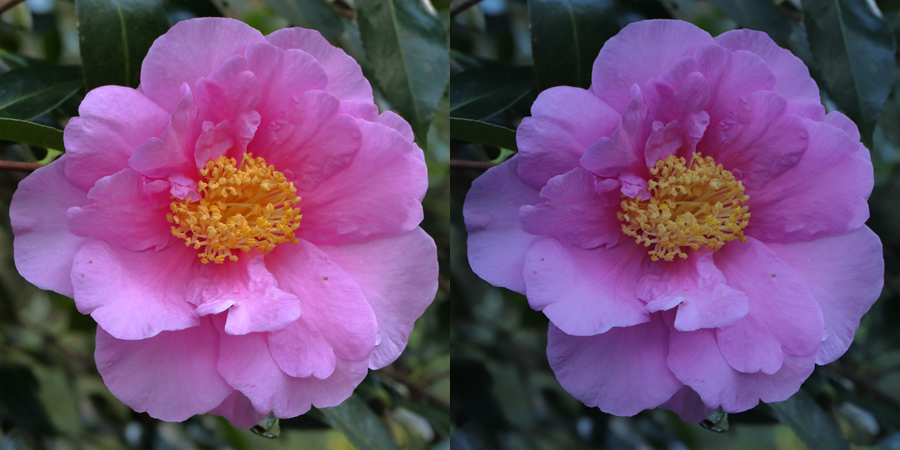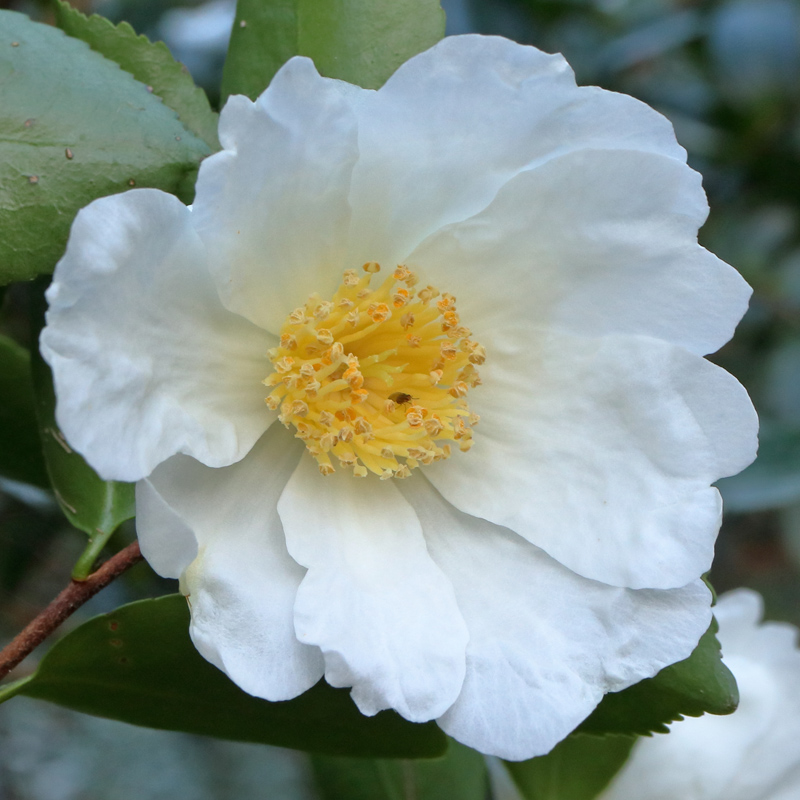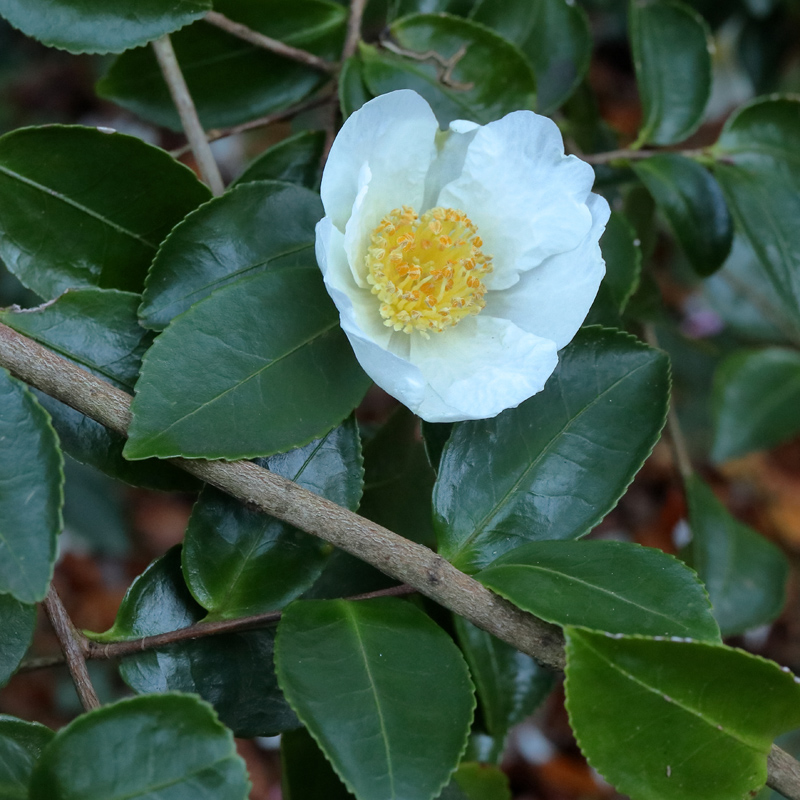It being sasanqua season, which always seems particularly fleeting, I have been looking again at plants that appear to be wrongly labelled in an attempt to identify them correctly.
In Area 10 at Mount Edgcumbe there is a plant labelled C. oleifera and another labelled C. sasanqua ‘Fukuzutsumi’. Both have been flowering for a couple of weeks and I have been comparing them very closely. As far as I can tell they are identical.
The flowers are pure white, just occasionally having a touch of pink on the outside of the bud. They are 8-10 cms. across, initially cupped but opening out almost flat. They have the usual sasanqua scent, quite strongly.
C. oleifera is a very widely grown species in China, cultivated for oil production and may be expected to be variable. However, in Collected Species of the genus Camellia its flowers are said to be 5.5-7cm across and too small for the plant to have much ornamental value.
C. sasanqua ‘Fukuzutsumi’ is a name that has been applied to more than one variety; the Camellia Register lists three. There is a white single, a red and white single and a red semi-double. The only entry with any reference to the plant outside of Japan is the red and white one, a view supported by pictures in Macaboy’s Illustrated Encyclopaedia and 1001 camellias in Nantes and Brittany. There are also images on Camellia.pics. All show a single flower, white at the centre and grading to pink at the edges.
Having concluded it seemed unlikely that the Mt Edgcumbe plants were either C. oleifera or C. sasanqua ‘Fukuzutsumi’, I posted the pictures above on the Rhododendron, Camellia and Magnolia Group Facebook page and I am grateful to Dan Everard for steering me towards C. sasanqua ‘Fragrans’.
It seems likely that both the Mt Edgcumbe plants were obtained from reputable nurseries who were selling them in the belief that they were what they said they were. They may still be doing so. I now have another name to attach to this variety but what does it take to be certain that it is the right one? The Register entry for C. sasanqua ‘Fragrans’ is not especially enlightening: “of graceful, erect habit, bearing ovate-lanceolate leaves and fragrant, white flowers which have a neat cluster of golden stamens”. That could apply to quite a few varieties. There is nothing about its origins. It was shown by Lt. Col. L. Messel of Nymans in 1938 so there may be an “original” plant still there.
Going back to Dan Everard’s pictures on Facebook at least one was of a young plant at Nymans. That strikes me as a basis for a fair degree of confidence in the identification. It is certainly a great deal more likely to be right than the two names I have at present.
As well as the flowers matching well, it has a rather distinctive leaf, a bit shorter and broader than many of its kin. It’s the foliage at least as much as the flowers that I am looking at when comparing plants. There is a second plant at Mt Edgcumbe labelled C. ‘Fukuzutsumi’ which was badly damaged by a tree falling on it a year ago. It has no flowers, but the similarity of the foliage leaves little room for doubt that it is the same variety as well.
I wonder where the Nymans plant came from. Did they raise it there? It seems unlikely; more likely it came from Japan and was given the name here. Is it grown in other countries under a different name?
Unconnected with Mt Edgcumbe the variety C. sasanqua ‘Cotton Candy’ came across my radar this week accompanied by a big question mark about identity. Back in my nursery days I had bought liners of this in 1996. They came from Liners New Zealand along with ‘Fairy Wand’ and ‘Jean Claris’. I had no reason to doubt the accuracy of their naming and the internet had barely started so checking on it would have been much more difficult. A couple of the original batch of 25 were planted at the nursery as stock plants and many more cuttings taken in later years. As it turns out, all were ‘Plantation Pink’. To anyone who bought ‘Plantation Pink’, wrongly labelled ‘Cotton Candy’, I apologise.

Let me end on a positive. Every year without fail I am amazed anew when Camellia ‘Show Girl’ comes into bloom. The autumn/winter camellias in the main have medium sized or small flowers, as often as not singles. Their impact largely comes from the lack of any competition at this time of year. ‘Show Girl’ is different. I measured two blooms at 14.5cms across, nearly 6 inches. It would be a large flower among the bigger spring bloomers.

This plant grows in an opening surrounded by trees. It is shaded from direct sun but the sky above is blue. My camera, set to daylight, sees it as mauve. One day I will take a picture of something white beside it and correct the white balance but most of the camellias are in similar conditions and your eyes get used to it.





Hi Jim, Propagations from our Fukuzutsumi are made most years. The distinction I make from our plant is that the petals are attractively wrinkled identical to your picture. White no pink and scented. One family during the same period owned three of the major Sussex gardens of which The Messel estate Nymans is in the centre. All the families exchanged plants. The material from which our old plant was raised (or yours ?) could have come any one of five locations. You would not call the growth on our plant erect but the leathery leaf, although healthier than ours, is a good match.
At the moment we have an old variagated pink flowered camellia in bloom. It does not look like a sasanqua, it has more of a japonica shaped leaf – can you match that with anything you have in the collection ? Show Girl is a very good thing. Do you have Pink Goddess or Paradise Gillian in the collection ? Yes, that matches our Plantation Pink.
LikeLike
OK, I need to be very clear about all the threads here. You have a plant of ‘Fukuzutsumi’ which looks to be the same as the Mt Edgcumbe plant. I believe the Mt Edgcumbe ‘Fukuzutsumi’ to be identical to the Mt Edgcumbe oleifera and it appears, from Everards pictures of ‘Fragrans’ from Nymans, that the Mt Edgcumbe oleifera is in fact ‘Fragrans’. Does that not make your ‘Fukuzutsumi’ the same as ‘Fragrans’, or are you saying it is different?
My first thought for your old variegated pink japonica flowering now is ‘Daikagura’, I’ll send you a picture.
Mt Edgcumbe doesn’t have Pink Goddess or Paradise Gillian, did you have a particular reason for asking?
LikeLike
Hi Jim, I have ‘Fragrans’ from the Messel garden (original ?) under propagation. They are situated out doors and most produced a flower over a month ago. I could not detect much scent. The flowers on the Fukuzutsumi facing south are just opening. At this early stage I’m not prepared to say both plants are the same as each other. I will know better about the similarity next year when the young Messel plants flower again. More strength to your arm in getting these white sasaquas sorted out – I think they are well mixed up in the trade !
Pink Goddess is under propagation with one labelled for M.E.
LikeLike